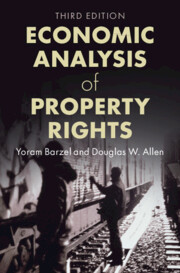Book contents
- Frontmatter
- Contents
- Figures
- Tables
- Preface to the Third Edition
- Preface to the Second Edition
- Preface to the First Edition
- Part I Conceptualissues
- 1 The Neoclassical Problem
- 2 Economic Property Rights
- 3 Transaction Costs
- 4 Information Costs
- 5 The Theory of Economic Property Rights
- Part II Contracts, Organizations, And Institutions
- 6 Exchange, Contracts, and Contract Choice
- 7 Divided Ownership and Organization
- 8 Institutions
- Part III Establishing Property Rights
- 9 Capture in the Public Domain
- 10 Forming Property Rights
- 11 Benefits of the Public Domain
- Part IV Non-Price Allocation And Other Issues
- 12 Nonwage Labor Markets
- 13 Property Rights in Non-market Allocations
- 14 Additional Property Rights Applications
- 15 The Property Rights Model
- References
- Index
- Political Economy of Institutions And Decisions
11 - Benefits of the Public Domain
Published online by Cambridge University Press: 17 August 2023
- Frontmatter
- Contents
- Figures
- Tables
- Preface to the Third Edition
- Preface to the Second Edition
- Preface to the First Edition
- Part I Conceptualissues
- 1 The Neoclassical Problem
- 2 Economic Property Rights
- 3 Transaction Costs
- 4 Information Costs
- 5 The Theory of Economic Property Rights
- Part II Contracts, Organizations, And Institutions
- 6 Exchange, Contracts, and Contract Choice
- 7 Divided Ownership and Organization
- 8 Institutions
- Part III Establishing Property Rights
- 9 Capture in the Public Domain
- 10 Forming Property Rights
- 11 Benefits of the Public Domain
- Part IV Non-Price Allocation And Other Issues
- 12 Nonwage Labor Markets
- 13 Property Rights in Non-market Allocations
- 14 Additional Property Rights Applications
- 15 The Property Rights Model
- References
- Index
- Political Economy of Institutions And Decisions
Summary
One of the greatest placements of wealth into the public domain was the US federal governments decision to issue large land grants to railroads and many small land grants to homesteaders in the nineteenth century. These lands were enormous in size, and putting them in the public domain induced a massive rush to get them. This chapter argues that the government wanted the lands to be taken and occupied, and that this was the benefit of placing them in the public domain, even though the racing was costly and they could have sold the lands.
- Type
- Chapter
- Information
- Economic Analysis of Property Rights , pp. 205 - 216Publisher: Cambridge University PressPrint publication year: 2023

